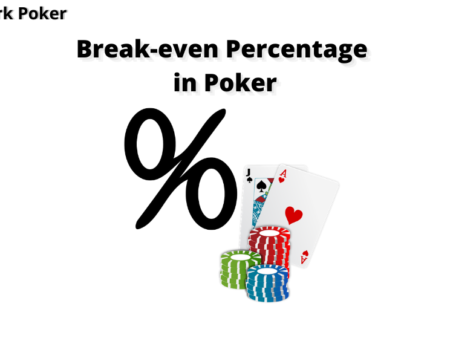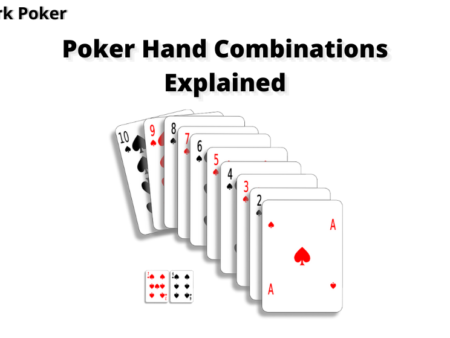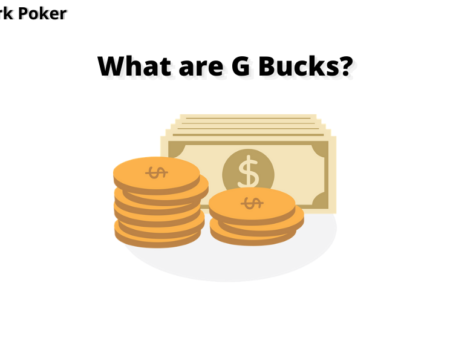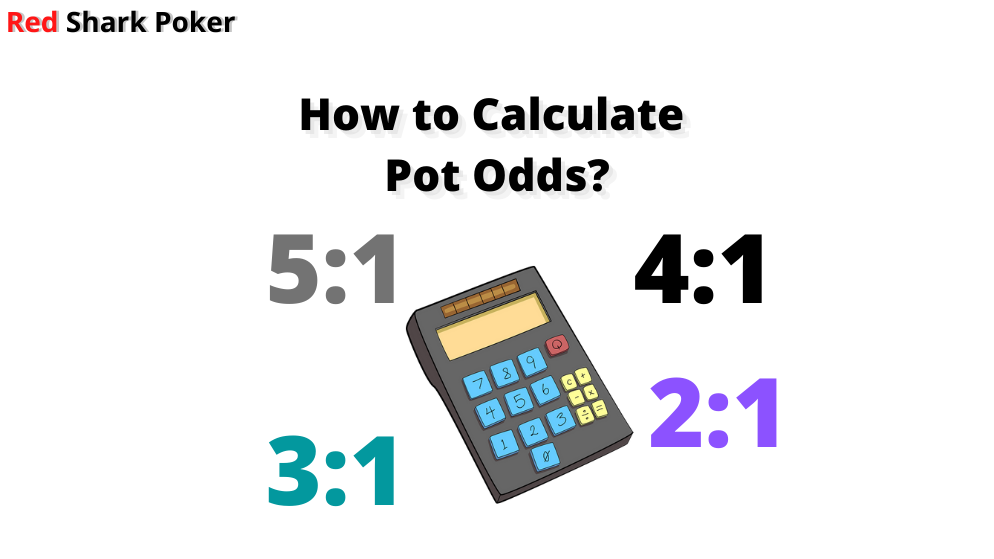
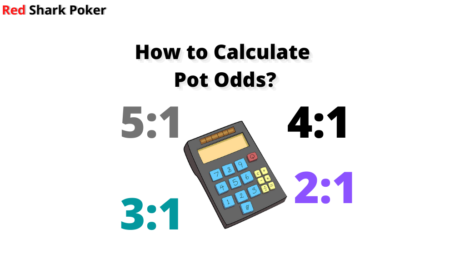
Pot odds is a fundamental and mathematical concept used in poker. Before you understand what pot odds are, take a look at the options below:
Option A: If you risk 1 cookie, you will get 2 cookies.
Option B: If you risk 1 cookie, you will get 5 cookies.
Which option will you choose? Definitely option B. You get 5 cookies for risking 1 cookie!
What if I replace cookie with 1 million dollars? How will it look like?
Option A: If you risk $1 million, you will get $2 million.
Option B: If you risk $1 million, you will get $5 million.
Notice any difference? The values have changed, but the ratio between the reward and risk is still the same. If you have noticed this difference, you have already grasped the meaning of pot odds!
So, without any further ado, let’s delve into the fundamental concept of pot odds in poker!
What are Pot Odds in Poker?
Poker pot odds is a mathematical expression of risk and reward. Pot odds tell you how much do you need to risk in order to win a reward. It is the ratio between the reward and the risk.
Reward = Pot to be Won
The pot can be at any point of the game – preflop, flop, turn or river.
Risk = How much you need to risk in order to win the pot
The risk is the size of someone’s bet/raise/re-raise you are facing. It is the amount you need to call in order to win the pot.
Pot odds = Reward : Risk
It is the ratio of the size of the pot (reward) to the amount you have to call (risk).
For example:
If there is $6 in the pot and your opponent bets $3, the pot becomes $9. In order to win the pot of $9, you need to call $3. So, what are the odds?
Reward = $9 (Size of the Pot)
Risk = $3 (Size of the Call)
Pot Odds = $9(Reward):$3(Risk)
= 9:3, which can be simplified to 3:1
Hence, the pot odds are 3:1. You can look at these odds in two ways.
- You need to pay 1/3 of the pot for a chance to win the whole pot
- You will get 3X the reward of your risk
Poker Pot Odds Example
Alert! This can be a bit mathematical but an easy hack to learn the odds quickly is available right after the example.
So, have some patience and continue reading…
In this example, we will not be looking at the hole cards so that you are solely focussed on the concept of poker odds.
Here’s the situation: You are on the Button in a $1/$2 6-max game. The Under the Gun (UTG) calls $2. The Middle Position (MP) raises to $5. Let’s calculate the pot odds.
If you don’t know what positions are, go through this: Poker Positions Explained
Preflop
Total pot (Reward) = $1 (small blind) +$2 (big blind) + $2 (UTG’s call) + $5 (MP’s raise)
= $10
Amount to Call (Risk) = $5
Pot Odds = $10 (Reward):$5 (Risk)
= 2:1
You decide to call, and others fold. The total pot is now $15 ($10 in the pot + $5 your call)
Flop
On the flop, the MP makes a half-size pot bet of $7.5. What are the odds now?
Total Pot = $15 (already in the pot) + $7.5 (MP’s bet)
= $22.5
Amount to Call = $7.5
Pot Odds = $22.5:$7.5
= 3:1
You decide to call, and the total pot is now $30 ($22.5 in the pot +$7.5 your call).
Turn
On the turn, the MP makes a quarter of a pot-size bet of $7.5. What are the odds now?
Total Pot = $30 (already in the pot) + $7.5 (MP’s bet)
= $37.5
Amount to Call = $7.5
Pot Odds = $37.5:$7.5
= 5:1
You decide to call, and the total pot is now $45 ($37.5 in the pot + $7.5 your call).
River
On the river, the MP makes a full pot-size bet of $45. What are the odds now?
Total Pot = $45 (already in the pot) + $45 (MP’s bet)
= $90
Amount to Call = $45
Pot Odds = $90:$45
= 2:1
The pot odds on the river is now 2:1. So, if you call, you will get 2X the reward for your call.
As you can see, the odds increase or decrease on different streets. By using the poker odds, you get a clear picture of the reward you will earn for the risk you take.
A Shortcut to Know Your Pot Odds
An easy way to know the odds is to know how much is in the pot and the percentage of the pot your opponent bets.
- What’s the Pot Size?
- What Percentage of the Pot is Your Opponent Betting?
For example, if the pot is $100 and your opponent bets $25, you can say that he is making a 1/4 pot-size bet or he is betting 25% of the pot.
You can save this chart or print it and paste it on a wall next to your computer.
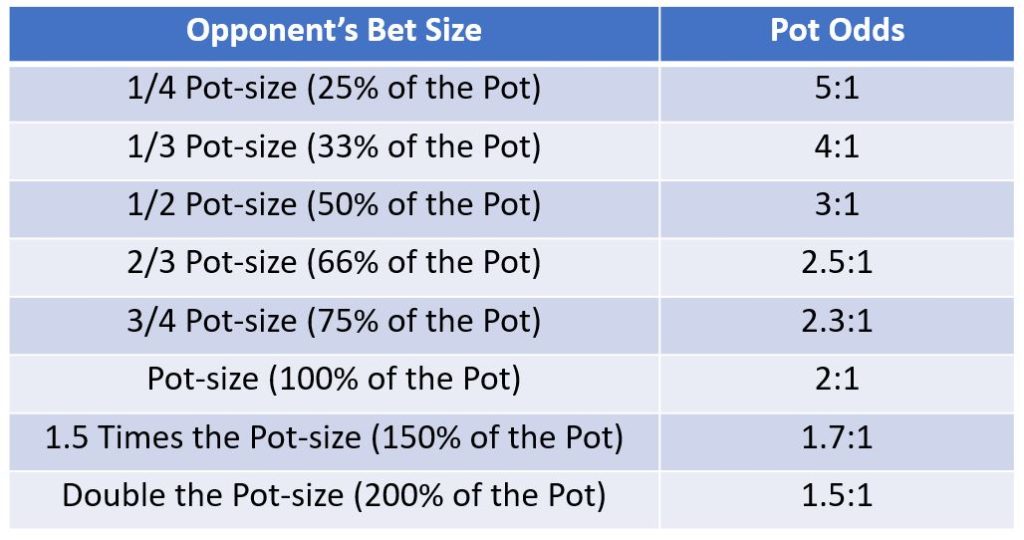
Why are Pot Odds used in Poker?
Pot odds tell you the ratio between the reward and the risk. It helps you to understand how much you need to risk to win the reward. But the real question is, “Is it worth the risk?” For that, you need to compare your card odds with the pot odds.
What are Card Odds?
It is the ratio between the cards you don’t want in the deck and the cards that you do want in the deck. In other words, it is the ratio of unwanted cards and cards we want (outs). If you don’t know what outs are, you can click here: How to Calculate Outs in Poker.
Card Odds = Cards we don’t need : Cards we need
Let’s look at the example below to understand this concept better:
Your Hand: 7♦ 6♦
Flop: 8♦ K♣ 2♦
Your opponent bets $25 into a pot of $100. The total pot is $125. You need to call $25 for a chance to win $125.
So, the pot odds are $125:$25 or 5:1.
In this scenario, you have 9 outs to complete your flush draw. Let’s calculate the odds now.
- A deck has 52 cards.
- We know 5 cards out of those 52 cards – Our 2 Hole Cards and 3 cards on the Flop.
- 52 – 5 = 47. There are 47 cards in the deck that we don’t know.
- There are 9 outs that will help us to make the flush. We need those 9 cards (outs).
- 47 – 9 = 38. We don’t need those 38 cards.
- Card Odds = Cards we don’t need : Cards we need
- Card Odds = 38:9
- 38:9 can be simplified as 4.2:1 or roughly 4:1
The card odds tell us that the odds of hitting a diamond on the next card is 4:1. Of course, any of the diamond-suited cards from the unknown 47 cards could have been dealt to other players. However, for the sake of simplicity, you can assume that for every 4 times, you won’t catch a diamond, 1 time you will.
Compare Pot Odds with Card Outs
The golden rule is that the pot odds should be greater than the card outs. When the odds from the pot are bigger than the odds of hitting an out, you will be winning more money than losing in the long run. So, the reward should be bigger than the risk.
Pot Odds > Card Outs
In the above example, we have the following odds:
Pot Odds = 5:1
Card Odds = 4:1
Pot Odds > Card Outs
We should call here as the pot odds are greater than card odds.
Card Odds Chart
It may be very difficult to do the addition and division to find the card odds while playing poker. You can save this card odds chart or print it to paste it on the wall. The chart has the common draw scenarios with the poker outs that you might face while playing poker. With a bit of practice, you will remember the important card odds.
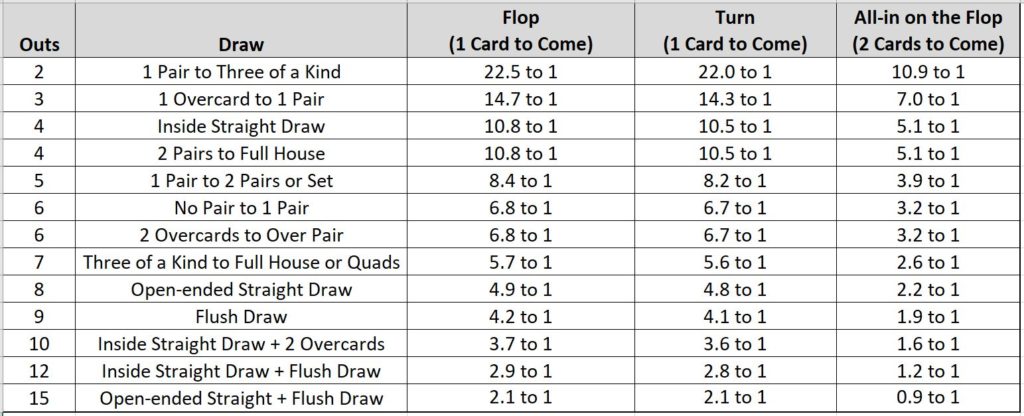
Note: The last column All-in on the Flop (2 Cards to Come) is in a situation when you or your opponent goes all-in on the flop. In an all-in situation, you don’t have to call bets on the turn or river. So, you will see 2 cards till the river. Seeing 2 cards instead of 1 improves your odds.
Let’s look at the example below for a quick exercise.
Your Hand: 7♦ 6♦
Turn: 8♦ K♣ 2♦ J♠
You have a flush draw with 9 outs.
Bet Size #1
Your opponent makes a quarter of a pot-size bet of $25 into a pot of $100. The total pot is now $125. You need to call $25 for a chance to win $125.
Pot Odds: 5:1 ($125:$25)
Card Odds: 4.1:1 (Look at the chart)
Pot Odds > Card Odds
Here, you can call as the pot odds are greater than the card odds. This means that you will be winning more money than losing in the long run.
Bet Size #2
In the same example, if your opponent makes a full pot-size bet of $100 into a pot of $100, the total pot becomes $200. You need to call $100 for a chance to win $200.
Pot Odds: 2:1 ($200:$100)
Card Odds: 4.1:1 (Look at the chart)
Card Odds > Pot Odds
Here, the card odds are greater than the pot odds. Although you might hit a flush on the river, calling here won’t be profitable in the long run. So, it will be wise to fold here.
Calculating Pot Odds Using the Percentage Method
Another way of calculating odds in poker is by using the percentage method. There are three simple steps in calculating the odds using the percentage method.
Step 1: Calculate the Final Pot
This is the major difference between the ratio method and the percentage method. In the percentage method, you need to add your call amount to the total pot to calculate the final pot. For example, if there is $6 in the pot and your opponent bets $3, the total pot becomes $9. Now add your call amount, which is $3, to calculate the final pot.
Total Pot = $6 (Already in the pot) + $3 (Opponent’s Bet)
= $9
Final Pot = $9 (Total Pot) + $3 (Call Amount)
= $12
Step 2: Divide the Call Amount by the Final Pot
Call Amount = $3
Final Pot = $12
3/12 = 0.25
Step 3: Multiply by 100
Multiply by 100 to get the percentage.
0.25 X 100 = 25%
So, the pot odds are 25%.
Poker Pot Odds Example Using the Percentage Method
Alert! This can be a bit mathematical but an easy hack to learn the odds quickly is available right after the example.
So, have some patience and continue reading…
Let’s review the example without looking at the hole cards to find the odds percentage.
You are on the Button in a $1/$2 6-max game. The Under the Gun (UTG) calls $2. The Middle Position (MP) raises to $5. Let’s calculate the odds.
Preflop
Total pot = $1 (small blind) +$2 (big blind) + $2 (UTG’s call) + $5 (MP’s raise)
= $10
Amount to Call = $5
Final Pot = $10 (Total Pot) + $5 (Call Amount)
= $15
Pot Odds = $5 (Call Amount) / $15 (Final Pot)
= 0.33
0.33 X 100 = 33%
So, the pot odds are 33%.
You decide to call, and others fold. The total pot is now $15 ($10 in the pot + $5 your call)
Flop
On the flop, the MP makes a half-size pot bet of $7.5. What are the odds now?
Total Pot = $15 (already in the pot) + $7.5 (MP’s bet)
= $22.5
Amount to Call = $7.5
Final Pot = $22.5 (Total Pot) + $7.5 (Call Amount)
= $30
Pot Odds = $7.5 (Call Amount) / $30 (Final Pot)
= 0.25
0.25 X 100 = 25%
So, the pot odds are 25%.
You decide to call, and the total pot is now $30 ($22.5 in the pot +$7.5 your call).
Turn
On the turn, the MP makes a quarter of a pot-size bet of $7.5. What are the odds now?
Total Pot = $30 (already in the pot) + $7.5 (MP’s bet)
= $37.5
Amount to Call = $7.5
Final Pot = $37.5 (Total Pot) + $7.5 (Call Amount)
= $45
Pot Odds = $7.5 (Call Amount) / $45 (Final Pot)
= 0.17
0.17 X 100 = 17%
So, the pot odds are 17%.
You decide to call, and the total pot is now $45 ($37.5 in the pot + $7.5 your call).
River
On the river, the MP makes a full pot-size bet of $45. What are the odds now?
Total Pot = $45 (already in the pot) + $45 (MP’s bet)
= $90
Amount to Call = $45
Final Pot = $90 (Total Pot) + $45 (Call Amount)
= $135
Pot Odds = $45 (Call Amount) / $135 (Final Pot) = 0.33
0.33 X 100 = 33%
So, the pot odds are 33%.
A Shortcut to Know Your Pot Odds Percentage
An easy way to know the odds is to know how much is in the pot and the percentage of the pot your opponent bets.
- What’s the Pot Size?
- What Percentage of the Pot is Your Opponent Betting?
For example, if the pot is $100 and your opponent bets $25, you can say that he is making a 1/4 pot-size bet or he is betting 25% of the pot.
You can save this pot odds chart or print it and paste it on a wall next to your computer.
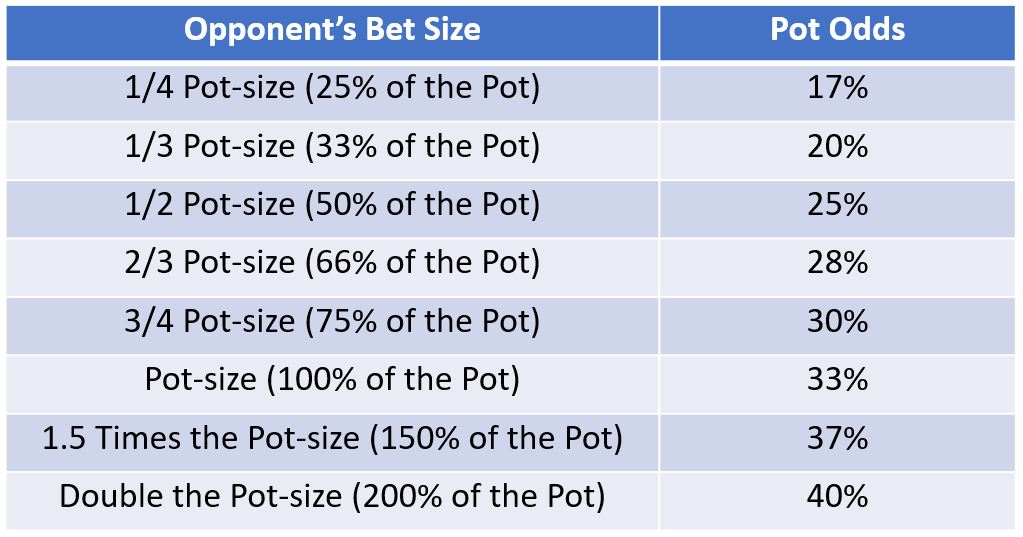
How is the Percentage used in Poker?
In the percentage method, you need to find the card equity and compare it with odds percentage to make a decision. Card equity is as same as card odds. Instead of using a ratio, it is expressed in percentage.
How to Find Card Equity?
Card equity can be accurate if you know what range of hands your opponents are holding. There are many equity calculators available online. Since this is an introductory chapter on poker pot odds, we will teach you the simplest way to calculate card equity.
Equity on the Flop Waiting for the Turn
= Number of Outs X 4
Equity on the Turn Waiting for the River
= Number of Outs X 2
Let’s look at the example below to calculate the equity.
Your Hand: 7♦ 6♦
Flop: 8♦ K♣ 9♠
You have an open-ended straight draw with 8 outs.
Equity on the Flop
= 8 outs x 4
= 32%
Turn: 8♦ K♣ 9♠ 2♥
Equity on the Turn
= 8 outs x 2
= 16%
Compare Pot Odds with Equity
The golden rule is that the equity should be greater than the pot odds. When the equity is greater than the pot odds, you will be winning more money than losing in the long run. Here, the reward is bigger than the risk.
Equity > Pot Odds
Let’s look at the example below to compare the odds and equity.
Your Hand: 7♦ 6♦
Turn: 8♦ K♣ 2♦ J♠
You have a flush draw with 9 outs.
Bet Size #1
Your opponent makes a quarter of a pot-size bet of $25 into a pot of $100. The total pot is now $125. The final pot is $150 (total pot + call amount).
Pot Odds: 17% (25/150 X 100)
Equity on the Turn
= 9 (outs) X 2
= 18%
Equity > Pot Odds
Here, you can call as the equity is greater than the pot odds. This means that you will be winning more money than losing in the long run.
Bet Size #2
In the same example, if your opponent makes a full pot-size bet of $100 into a pot of $100, the total pot becomes $200. The final pot is $300 (total pot + call amount).
Pot Odds: 33% (100/300 X 100)
Equity on the Turn
= 9 (outs) X 2 (Turn)
= 18%
Pot Odds > Equity
Here, the pot odds are greater than the equity. Although you might hit a flush on the river, calling here won’t be profitable in the long run. So, it will be wise to fold here.
An easy way to find out how much equity is required for you to call is to find out the percentage of the pot your opponent bets. Remember these odds against your opponent’s bet sizes.
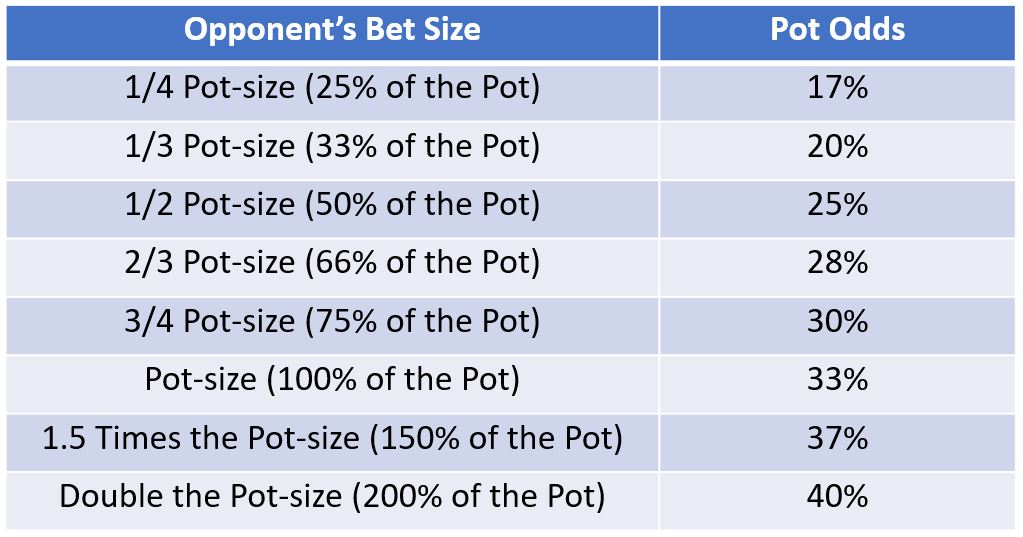
Conclusion
It might be a little overwhelming for the first time to grasp the concept of pot odds. However, with a bit of practice, you will get used to it. We recommend you to save all the charts or print them and paste it on the wall to take quick decisions. Poker is a mathematical game, and if you get your numbers right, you will always win money in the long run!

